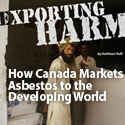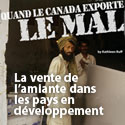In his six month review of complaints of improper conduct by McGill Professor Emeritus John McDonald, McGill’s research integrity officer, Dr Abraham Fuks, ignored evidence, submitted to him, of collusion by Prof. McDonald in the efforts of the asbestos industry to cover up disturbing evidence of asbestos harm. In his report, released October 17, 2012, Dr Fuks rejected the complaints, saying that he had found no evidence of any impropriety on the part of Prof. McDonald.
New medical evidence, released in 1972 by the medical officer working for the Turner Brothers Company Asbestos factory in the UK, showed that 40% to 50% of workers at the factory had lung abnormalities, whereas a few years earlier, the previous medical officer at the factory had reported that only 7 or 8% of X-rays of workers’ lungs at the same factory showed abnormalities.
The asbestos exposure standard in the UK at this time allowed workers to be exposed to 2 fibres of asbestos per cubic centimetre of air (2 f/cc) and this standard had been decided on the basis of the earlier 7 or 8% statistics of harm caused. The new data showed that the 2 f/cc standard was not adequate. The US the exposure standard at the time was 5 f/cc and the U.S. National Institute for Occupational Safety & Health (NIOSH) and the trade union movement were calling for the U.S. standard to be changed to 2 f/cc. The asbestos industry and Prof. McDonald opposed NIOSH’s recommendation and argued that the 5 f/cc exposure standard should be kept unchanged.
Dr Irving Selikoff, a leading U.S. occupational health expert, stated that the new data, showing 40 to 50% of workers harmed, changed the entire picture on asbestos standards and that the U.S. 5 f/cc standard placed “U.S. asbestos workers at serious risk of irreversible, often fatal disease and in my opinion, it should immediately be reconsidered.”
Johns-Manville and other asbestos companies were determined to suppress this new evidence of asbestos causing higher levels of harm than previously recognized, so as to block efforts by Dr Selikoff, NIOSH and trade unions to obtain stricter occupational safety standards for asbestos workers, which would have cost the industry millions of dollars to implement.
Notes of a 1973 meeting of leading asbestos executives attended by J. Solon, Jr., Vice-President, Johns-Manville, Ivan Sabourin, lawyer for Johns-Manville Canada, John Marsh, President of the Asbestos Information Association/North America (AIA/NA), Matthew M. Swetonic, Executive Secretary of the AIA/NA, that Prof. McDonald also attended, show that McDonald encouraged this cover-up by the asbestos industry.
Other asbestos industry records show how the asbestos industry executives rejoiced at their success in blocking the adoption of the 2 f/cc exposure standard. The exposure standard in the U.S. thus continued to be 5 f/cc until 1976. Today the exposure standard in western countries is 0.1 f/cc or 00.1 f/cc. In Canada also, workers fought to get stricter safety protections, but it was not until 1976 that they succeeded in getting the 2 f/cc standard adopted. The 2 f/cc standard was, of course, inadequate and allowed workers to be exposed to great harm.
How many workers lost their lives because of the success of the asbestos industry and Prof. McDonald in blocking stricter protections for asbestos workers?
Below is a letter sent to McGill’s research integrity officer, Dr Abraham Fuks, bringing this collusion by Prof. McDonald with the asbestos industry cover-up to his attention.
Dr Fuks excluded this matter from his report.
== ==
Sent: Monday, May 07, 2012
To: Dr. Abraham Fuks
Subject: Covering up disturbing medical evidence of asbestos harm
Dear Dr Fuks,
Attached is a report, written by F. J Solon, vice-president of public relations for Johns-Manville Asbestos, regarding a 1973 trip to the UK made by Solon, Ivan Sabourin (the lawyer for QAMA who stole body samples of Quebec miners and illegally transported them across the US border in order to hide evidence), John H. Marsh, of Raybestos-Mannhattan and President of the Asbestos Information Association/North America (AIA/NA, he industry lobby group) and Matthew M. Swetonic, Executive Secreatry of the AIA/NA.
As the report states, the purpose of the trip related almost entirely to the reopening of the OSHA Asbestos Standard in the US. The asbestos industry at that point in time was terrified that the exposure standard of 2 f/cc, that was then in effect in the UK, would be lowered in the UK & the US, in light of growing evidence that a stricter standard was necessary. AT the OSHA hearing in 1972, the Senior Vice-President of Johns-Manville, Henry Moreno, forcefully argued that it would cost Johns-Manville capital expenditures of 12 million dollars and operating expenditures of 5 million dollars per year, if the recommendation to lower the permitted asbestos exposure level from 5 f/cc to 2 f/cc were to be approved by OSHA. The industry knew, however, that, in reality, they needed to mount a huge fight to stop the standard being made stricter than 2 f/cc.
The 2 f/cc standard in the UK had been based on X-ray data of 290 men working at a Turner Brothers Asbestos Company factory. This data had been provided by Dr John Knox, the company’s medical officer. Dr Knox had reported that 7 or 8% of X-rays of workers’ lungs showed abnormalities. However, just a few years later, an analysis of X-rays of workers’ lungs by the company’s new medical officer, Dr Hilton Lewinsohn, showed 40% to 50% of workers at the same facility had lung abnormalities.
As would anyone genuinely concerned about worker health and accurate scientific information, Dr I. Selikoff was greatly disturbed by this new data and he asked to be able to examine the X-rays. The asbestos industry executives did everything they possible could to suppress the new data, to not allow the X-rays to be examined by any independent experts, to sabotage Dr Selikoff’s efforts to address this shocking situation and to attack Dr Selikoff personally. From the point of view of the asbestos industry, it was imperative that this new information be suppressed, since it clearly threatened to lead to a demand for more stringent regulations with lower exposure levels in both the UK and the US, which they were determined to prevent from happening. I attach the letter that was sent by Turner Newall to Dr Selikoff (the letter starts at the end of the document).
The attached document by Mr Solon reports the frantic manner in which the asbestos industry, encouraged and supported by Prof. McDonald, conspired to keep this critical medical evidence hidden. It is in keeping with many other actions by the asbestos industry to suppress evidence, such as described in the attached article Deadly Secret, as just one other example.
The section in Dr Castleman’s book Asbestos: Medical & Legal Aspects on the Development of the Current U.S. Asbestos Standard (page 269 onwards) and, in particular pages 275 onwards, provide information on the gravity of the wrong-doing that was being perpetrated at these UK 1973 meetings to cover up the harm being caused to workers by asbestos, which even Turner Newall’s medical officer, to the displeasure of the company, had documented. Please also see McCulloch & Tweedale, pages 103 to 109.
Dr Fuks, a person who is a medical doctor has an obligatory duty, that cannot be bartered away, to put the protection of human life ahead of all else. Could you, as a medical doctor, turn aside and help cover up vital medical information showing risk to life? If you were working for an industry that had vested interests in covering up that evidence of harm to health, would you collude with the efforts of that industry to cover up and obfuscate the evidence? I believe that you would not do so.
A person who is a reputable academic has an obligatory duty, that cannot be bartered away, to put scientific evidence ahead of all else and not to collude in the suppression of evidence that is inconvenient to vested interests. I trust that you agree.
I consider this example of Prof. McDonald’s betrayal of scientific integrity and betrayal of his duty to protect health to be extremely serious. I hope you do also. I hope that both you and McGill will judge that this conduct violates the standards of intellectual and ethical honesty that McGill upholds and that citizens count on McGill to uphold.
Sincerely,
Kathleen Ruff



Mon, Oct 22, 2012
Asbestos, Misc.